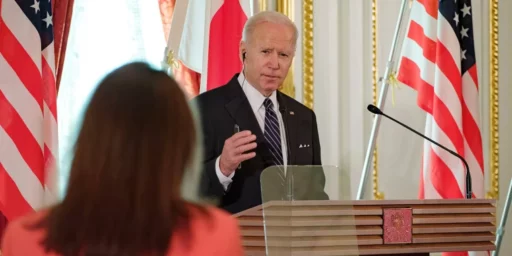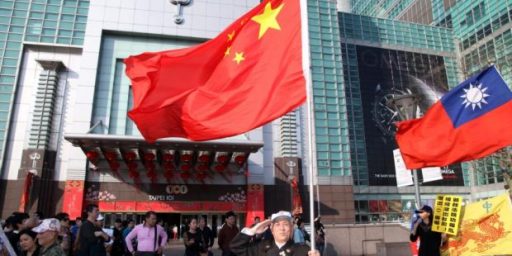Chinese Military Build-Up
What started out as a post on China’s rebuilding its submarine fleet has turned into a rather unorganized flurry of excerpts as I’ve turned up other articles. I’m going to leave the post in rough draft form and move it to the extended entry. My plan is to write a more substantive piece on the issue for publication elsewhere.
Washington Times – Chinese Produce New Type Of Sub
China’s naval buildup has produced a new type of attack submarine that U.S. intelligence did not know was under construction, according to U.S. defense and intelligence officials. The submarine was spotted several weeks ago for the first time and has been designated by the Pentagon as the first Yuan-class of submarine. A photograph of the completed submarine in the water at China’s Wuhan shipyard was posted on a Chinese Internet site this week and confirmed by a defense official as the new submarine. Wuhan is located inland, some 420 miles west of Shanghai.
One official said the new submarine was a “technical surprise” to U.S. intelligence, which was unaware that Beijing was building a new non-nuclear powered attack submarine. U.S. intelligence agencies have few details about the new submarine but believe it is diesel-powered rather than nuclear-powered, said officials who spoke on the condition of anonymity. The new boat, which appears to be a combination of indigenous Chinese hardware and Russian weapons, suggests that China is building up its submarine forces in preparation for a conflict over Taiwan, defense analysts say. “China has decided submarines are its first-line warships now, their best shot at beating carriers,” said Sid Trevethan, an Alaska-based specialist on the Chinese military. “And China is right.” “One has to marvel at the enormity of the investment by the People’s Liberation Army in submarines,” said Richard Fisher, a specialist on the Chinese military.
China also is building two nuclear-powered submarines — one Type 093, believed to be based on the Russian Victor-III class and armed with intercontinental ballistic missiles, and a Type 094 attack submarine, which the Pentagon believes has a finished hull and will be ready for deployment next year. According to Mr. Trevethan, China currently has a force of 57 deployed submarines, including one Xia-class nuclear ballistic missile submarine, five Han submarines, four Kilos, seven Songs, 18 Mings and 22 Soviet-designed Romeos. Beijing also has eight more Kilos on order with Russia.
Disclosure of the new submarine comes as the United States is trying to sell eight diesel submarines to Taiwan, which Beijing views as a breakaway province. Taiwan currently has just two World War II-era Guppy-class submarines and two 1980s Dutch submarines. Mr. Fisher, an analyst with the International Assessment and Strategy Center, said that despite the imbalance of power on the Taiwan Strait in favor of Beijing, the Bush administration has been slow to sell the submarines it offered Taiwan in April 2001. “It is simply appalling that the United States cannot get its act together to organize the production of eight new submarines for Taiwan,” Mr. Fisher said. U.S. defense officials have said delays with the Taiwan submarine deal are the result of the Taipei government’s budget problems. Chinese leaders told National Security Adviser Condoleezza Rice last week that China would “not sit idly by” as Taiwan moved toward formal independence, and President Hu Jintao denounced U.S. weapons sales to Taiwan.
But Miss Rice said the United States will go ahead with its Taiwan arms sales plan because of China’s missile buildup opposite the island.A Pentagon report made public in May stated that China is changing its warship forces from a coastal defense force to one employing “active offshore defense.” “This change in operations requires newer, more modern warships and submarines capable of operating at greater distances from China’s coast for longer periods,” the report said, noting that submarine construction is a top priority. Mr. Fisher said the Chinese submarine buildup should prompt the Pentagon to step up U.S. anti-submarine warfare capabilities, which he said are “at an historic low” because of cutbacks in specialized ships and aircraft. The Navy should consider building its own diesel attack submarine to be able to “effectively duke it out with the new tidal wave of Chinese subs, that if left unchecked, may soon dominate the Asian littoral regions,” Mr. Fisher said. The Pentagon is also building up U.S. naval forces in the Pacific, with the addition of up to six attack submarines in Guam and the possible deployment of an aircraft carrier battle group to Hawaii in the coming months.
This is interesting on a number of fronts. For one thing, we may finally be getting to the point–predicted for decades now–where China is a significant military rival. A significant submarine fleet would greatly enhance their ability to project power throughout the Asia-Pacific region.
It also shows, once again, the nature of intelligence. Despite having paid strong attention to China for decades and knowing that they were intent on building up their naval forces, they managed to build a new class of submarine without our knowledge. Even having seen and photographed it, we’re still having to guess as to even basic details as whether it’s nuclear- or diesel-powered. This demonstrates, rather clearly, why waiting until one has rock solid evidence is often not an option. Detecting the construction of a submarine would seem radically easier that spotting the production of chemical weapons, for example.
Update (0910): The submarine fleet isn’t the only thing the Chinese are expanding.
WSJ [$] – The New Weapon In China’s Arsenal: Private Contractors
When China’s military wanted to buy equipment for a new communications network, it bypassed the state-owned defense contractors that had once catered to its needs. Instead it turned to a young, private company run by a former army engineer. Operating from a landscaped corporate campus in this booming city adjacent to Hong Kong, Huawei Technologies Co. speedily filled the order. In 2000 and 2001, company engineers installed routers, switches and other gear to connect military command centers across China, according to former executives and an engineer involved in the installation. As a result, the military got a network that’s faster, more reliable and, foreign military experts say, less susceptible to U.S. eavesdropping.
After decades as a lumbering giant, the People’s Liberation Army is on the verge of fielding a military force commensurate with China’s strategic ambitions. To get there, Chinese leaders have abandoned old principles and are harnessing the country’s increasingly free-market economy to build a competitive defense industry. The PLA has dug ditches to lay fiber-optic cables for commercial telephone operators in return for extra bandwidth. The government is doling out billions of dollars to fund the private development of cutting-edge technologies. And the country’s retooled commercial shipyards are booming.
Encouraging the commercial sector is just one way that China is beefing up its military capabilities. In recent years, Chinese commanders have shredded war-fighting doctrines based on the communist revolution and have rolled out new regimens for recruitment, training and combat. As a result, Washington’s foreign-policy establishment is worrying about China again. The Bush administration, which had largely reined in its concerns after Sept. 11, is reassessing the country’s capabilities, especially in light of the U.S.’s legal obligation to help protect Taiwan.
“The Chinese have leapfrogged,” says James Mulvenon, a Chinese military specialist with Rand Corp., a think-tank often commissioned by the U.S. government to study security issues. “Don’t comfort yourself by thinking that they’re not formidable.”The PLA isn’t likely to catch up with the U.S. for a long time, foreign military analysts say. Its 2.25-million-member force, the world’s largest, is largely land-bound. It has an improving arsenal of missiles but underpowered naval and air forces; they and the infantry rarely train together. China also still relies on Russia and other foreign suppliers for major weapons systems. Defense attachés who have visited Chinese ships describe seeing a mish-mash of electronics, some of it commercially available. Only in recent years have commanders boasted of a new capability — encrypted e-mails.
***
China’s strategic ambitions and key aspects of its modernization program remain largely under wraps. The Ministry of Defense and the PLA command declined to comment for this article, and the PLA’s main strategy documents are classified. Chinese leaders have publicly stated that their military build-up is defensive. Any war would risk China’s international standing and dent the trade and investment that buoy its economy. Nonetheless, foreign experts don’t doubt the seriousness of China’s modernization effort. “This modernization isn’t rapid, but it’s very determined,” says Dennis Blasko, a former military attaché in Beijing for the U.S. Army.
***
The military is also happy to buy equipment from China’s booming commercial tech sector, rather than waiting for the development of specialized equipment. That’s allowing the PLA to catch up faster, says Richard Bitzinger, a researcher at the Asia-Pacific Center for Security Studies in Honolulu, the think-tank for the U.S. Pacific Command. “For most military computers, using Pentium chips is good enough,” says a PLA senior colonel involved in long-range strategic planning.
With its growing proficiency, the PLA is making a concerted push into information warfare — the use of computer viruses to paralyze an enemy’s financial markets or traffic systems. The PLA has opened an information-warfare center and is training special units in these skills, according to Shen Weiguang, a former aide to the PLA’s recently retired chief of staff and a lecturer at military academies on warfare trends. In 1996, the PLA couldn’t track two U.S. aircraft-carrier groups that Washington dispatched to Taiwan, recalls Mr. Shen. “We’re not deaf and blind anymore. If you come, we’ll know,” he says.
All these changes are giving China’s leadership real military options for the first time in decades. Military analysts think the PLA still lacks sufficient naval and air power to launch a full invasion of Taiwan, for example. But the areas where the PLA is making its greatest strides — commando forces, information warfare and missiles technology — could, if deployed together in a few years time, demolish Taiwan’s military bases and command centers, according to a Pentagon assessment of the PLA’s capabilities.
A worrisome trend, especially as combined with a piece noted by Richard in the comments below.
Sydney Morning Herald – China and Taiwan: flashpoint for a war
Concern about a Chinese military strike against the US-shielded Taiwan has sharpened drastically since the island’s independence-leaning President, Chen Shui-bian, gained a new term in the March elections and foreshadowed changes to its constitution. *** Numerous US analysts believe that China’s military is close to reaching the capability it sees as necessary for an attack om special forces in Taiwan before the US Navy could execute its 30-day “surge” of massive reinforcements to the region – a Chinese version of US Defence Secretary Donald Rumsfeld’s “shock and awe”. The decisive moment could come even as early as Taiwan’s elections for its legislature this December, when Chen’s Democratic Progressive Party is expected to sweep out many of the conservative Kuomintang (KMT, Chinese Nationalist) oppositionists who have so far protected the existing constitution that sees Taiwan as part of China.
But most see 2006, when Chen introduces his constitutional reforms, as a critical time. Repeatedly, in recent months, Chinese spokesmen have warned that any price – large casualties and physical damage, broken diplomatic ties, economic reverses, and disruption of the 2008 Olympics in Beijing – will be paid to prevent Taiwan declaring its independence.
The simmering Taiwan issue thus holds the distinct possibility of a major Pacific security crisis for whoever wins the US presidential elections in November. For whoever wins the next Australian federal elections, the dilemma will be perhaps even more acute, with Canberra having to balance its ANZUS alliance calls against the sudden new importance of China as a trade partner and regional power. “In any conflict between the US and China, China would eventually – probably quite quickly – need to restore good relations with the US and vice versa,” says Stuart Harris, an Australian National University analyst of East Asia and a former head of the Department of Foreign Affairs and Trade. “A country like Australia, however, if on the US side, would not be easily forgiven. We would be punished for a very long time.”
More stories:
CNN – China’s war game warning to Taiwan
Reuters – Pentagon War Game Based on China Threat to Taiwan
Background at The Intelligence Network
Christopher B. Pultz, “The PLA and China’s Changing Security Environment,” Strategic Insights (January 2003).
H. Lyman Miller, “China’s Upcoming Leadership Changes and the PLA,” Strategic Insights (August 2002).






There is something going on with the People’s Liberation Army’s submarines, that is certain.
The Type 093 sub mentioned is also worrisome, though “based on the Russian Victor-III class and armed with intercontinental ballistic missiles†doesn’t make sense, because the hull would not be big enough for ICBMs/SLBMs. Strategy Page has it listed as an SSGN (cruise missile sub) instead, which can be employed against carriers, as well as land targets (SWAG on range, 1-2000 kms, not intercontenental). China is producing the Zia 092 SSBN though, which can threaten the US West Coast, in addition to the Asian countries. China is definitely building up its submarine Navy (Army).
The part recommending the USA should start building diesel subs to counter China has been bouncing around for 15 years now, and has many arguments against it too. Isn’t going to happen.
Take a look at this article from the Sydney Morning Herald (you don’t have to Register, just hit the not now link). Article predicts 2006 as the “flash point†for China regarding Taiwan.
http://smh.com.au/articles/2004/07/13/1089694360063.html
Then do a news search there for “Taiwan.†– too many articles.
Quick correction, James.
China’s sub force doesn’t allow them to project power — but it could let them deny the US the ability to project power into the SW Pacific.
Which, for them, is plenty good enough.
Which, for them, is plenty good enough.
For the moment, at least. Establishing a “no play” zone in their region would be a big step toward eventually taking the hyperpower back down to superpower status, which would set the stage for China to emerge as the rival it has wanted to be since — realistically at least, as opposed to as an idea — the collapse of the Soviet empire.
“It also shows, once again, the nature of intelligence….Detecting the construction of a submarine would seem radically easier that spotting the production of chemical weapons, for example.”
This is very weak (at best) justification for our great new policy of preemption. It seems more plausible that our intelligence network is so rotten that we weren’t able to detect something we should have been able to detect.
Recent events should make it clear that our intelligence apparatus is fundamentally flawed. The failure to accurately detect something like this is not an argument for preemption, but an argument to improve our intelligence apparatus.